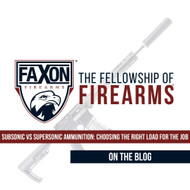Supersonic vs Subsonic Ammunition: Choosing the Right Load for The Job
Posted by Faxon Firearms Staff on Jul 20th 2023
When it comes to ammunition selection, understanding the differences between subsonic and supersonic rounds is crucial. These two categories are defined by their velocities in relation to the speed of sound, as their names imply. In this blog, we will explore the characteristics, best use cases, and considerations for subsonic and supersonic ammunition to help you make informed decisions.
Supersonic Ammunition:
Supersonic ammunition travels at speeds exceeding the speed of sound, around 1,100 fps, breaking the sound barrier and creating a sonic "crack" or boom. These rounds have distinct characteristics and are widely used in various shooting disciplines as they are the most commonly available choices for ammunition.
Best Use Cases:
Supersonic ammunition often provides an extended effective range and flatter trajectory, making it suitable for medium to long-range use cases. It finds applications in hunting, target shooting, and self-defense.
Considerations:
While supersonic ammunition offers versatility and longer reach, it comes with considerations. Increased noise can affect the shooter and those around them. Recoil and muzzle blast are also more pronounced. Additionally, faster projectiles have more penetration so target and backstop must be considered more carefully.
Transonic Phase: Destabilization in Flight
The transonic phase, or transonic line, is the point when a projectile slows down from supersonic speeds to subsonic speeds. The interaction between the bullet and surrounding air generates turbulence and fluctuations in pressure, introducing instability. This is particularly important in long range shooting as projectiles are no longer predictably accurate after passing the transonic line.
Center of Pressure Shift:
The center of pressure (CoP) can shift along the bullet's length during the transonic transition, affecting the distribution of aerodynamic forces and potentially causing pitching or yawing motions.
Buffet and Drag Changes:
Turbulent airflow around the bullet creates buffeting forces and changes in drag characteristics, adding complexity to flight dynamics and stability.
Potential for Tumbling:
The destabilizing effects of the transonic transition can lead to unstable flight conditions, causing the bullet to tumble or keyhole, resulting in erratic flight patterns and reduced accuracy.
Subsonic Ammunition:
Subsonic ammunition refers to rounds that travel at speeds below the speed of sound, typically around 1,000 fps or lower, never breaking the sound barrier. These rounds offer unique advantages in specific scenarios.
Definition and Characteristics:
Subsonic ammunition is designed to minimize noise by staying below the speed of sound. It achieves this through lower velocities and often utilizes heavier bullets to compensate for reduced speed.
Best Use Cases:
Subsonic ammunition is highly effective in suppressed firearms, providing a significant reduction in noise signature. It finds applications in military and police applications such asclose quarters shooting and tactical operations. Subsonic ammunition is also well suited to home and self-defense as well as close-range hunting in areas sensitive to noise pollution.
Suppressed Shooting:
The addition of a suppressor is where subsonic ammunition really shines. The fact that it does not break the sound barrier is already significantly quieter than its supersonic counterpart. Adding a suppressor further quiets the noise produced.
Considerations:
While subsonic ammunition excels in noise reduction and close-range precision, it has limitations. Its effective range is shorter compared to supersonic ammunition. Additionally, terminal ballistics and penetration may be reduced, requiring careful consideration for hunters. The reduced pressure of subsonic ammunition can also affect the function of semi-auto firearms.
.300 Blackout as an Example:
The .300 Blackout cartridge is an excellent example that offers both subsonic and supersonic loadings. It provides shooters with versatility and options for different shooting needs and performs well in both categories.
Supersonic .300 Blackout:
Supersonic .300 Blackout ammunition is a popular option for hunters and shooting enthusiasts alike, the projectiles available in the 110 to 180-grain range are highly popular for hog hunters in the south and southeast regions of the United States able to effectively take out feral hogs.
Subsonic .300 Blackout:
Subsonic .300 Blackout loads shine best when combined with a suppressor. Starting around 190 to around 220-grains these projectiles are very heavy for the caliber and moverelatively slow out of the muzzle of the firearm when fired. This makes for a quiet shooting experience when shooting .300 Blackout suppressed.
Additional Considerations:
Subsonic and Supersonic ammunitions will often perform differently based on other aspects of your firearm.With .300BLK as the example, a 1:8” twist rifled barrel is a versatile option that can use most supersonic and subsonic ammo effectively.If you are planning to use your .300 Blackout strictly with subsonic ammunition and a suppressor, you may want to look at something a little bit more specialized for your situation and needs. Something like a 1:5” twist barrel will help to impart more rotational energy onto the projectile as it flies and carries more energy into your target. I can also stabilize these heavier projectiles from shorter barrels.
Conclusion:
In conclusion, choosing between subsonic and supersonic ammunition depends on the specific shooting application, firearm platform, and ammunition characteristics. Subsonic rounds excel in noise reduction and short-range precision, while supersonic ammunition offers versatility and longer reach. Consulting manufacturers' recommendations and conducting thorough research will help you make informed decisions for your shooting needs.
If you have any questions at all, or need assistance in planning your next build, please do not hesitate to reach out to the Faxon Firearms customer service team. We are always happy to help, and we are happy to talk shop with you and answer your questions. They can be reached via email at customerservice@faxonfirearms.com or via phone at 513-280-8861.

